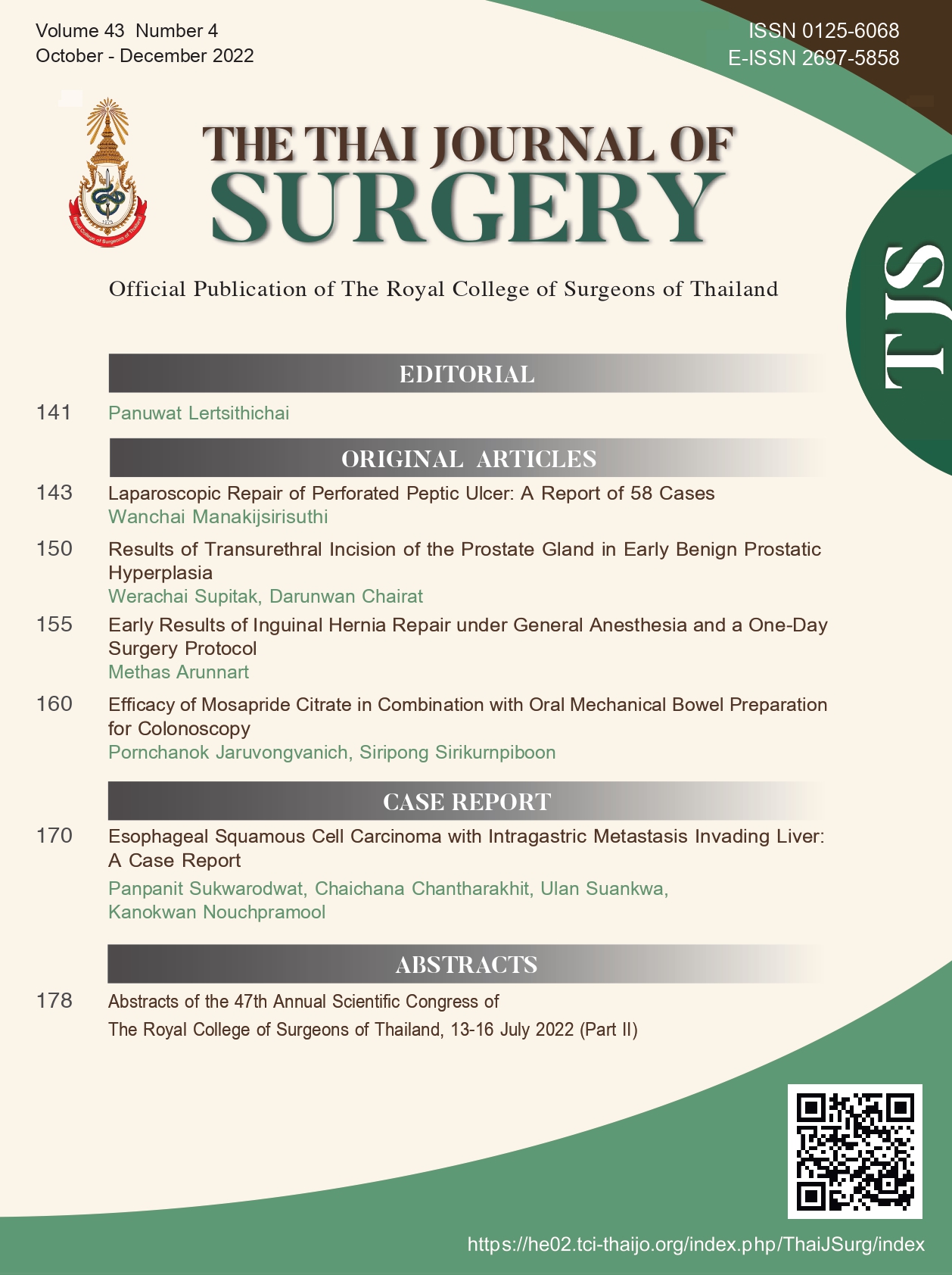Early Results of Inguinal Hernia Repair under General Anesthesia and a One-Day Surgery Protocol
Keywords:
Inguinal hernia, Herniorrhaphy, Under general anesthesia, One day surgeryAbstract
Objective: Several studies have shown that herniorrhaphy under general anesthesia (GA) could be done in a one-day surgery (ODS) setting. However, no studies have evaluated the outcomes and complications of this approach. We aim to evaluate the early outcomes of herniorrhaphy under GA in a ODS protocol.
Methods: Medical charts of patients who underwent herniorrhaphy between the years 2018 and 2022 were reviewed. Data on patient characteristics and early outcomes were collected. Patients with ASA class ≥ III, acute incarcerated hernia, strangulated hernia, and who did not have a good care provider were excluded.
Results: 100 patients underwent herniorrhaphy under GA in a ODS protocol. All patients were male. More than 50% of patients were between 41 to 60 years of age. The majority (71%) of cases had ASA class I. The average overall length of stay ± SD was 6.1 ± 0.3 hours.
Seven patients could not be discharged home on the same day due to urinary retention, surgeon’s concern, severe postoperative pain, and dyspnea. The average length of stay in patients who needed post-operative admission was 21.6 ± 6.5 hours.
The overall complication rate was 9%. Urinary retention was the main complication and the main cause of postoperative admission. There were no deaths, readmissions, or early recurrent inguinal hernia.
Conclusion: Herniorrhaphy under GA was effective and safe and could be done within a ODS setting. The rate of complication was low. Urinary retention was the main complication causing failure to discharge on the same day. However, these complications were not a serious problem and patients could usually be discharged the next day.
References
Baskerville PA, Jarret PEM. Day case inguinal hernia. Ann R Coll Surg Engl 1983;65:224-5.
Division of Medical Technical and Academic Affairs. Recommendations for the development of the service system ODS (One Day Surgery). Nonthaburi: Division of Medical Technical and Academic Affairs [Internet]; 2017 [cited 2019 September 20]. Available from: http://203.157.39.44/uploads/E000001/b052513ab8ca5dab33f0f425f186f801.pdf.
Argo M, Favela J, Phung T, et al. other forms of anesthesia for open inguinal hernia repair: a meta-analysis of randomized controlled trials. Am J Surg 2019;218:1008-15. doi:10.1016/j.amjsurg.2019.06.024.
Chainapapong K. Groin hernia repair under local anesthesia in one day surgery-8-year Experience. Thai J Surg 2019;40:27-34.
Pere P, Harju J, Kairaluoma P, et al. Randomized comparison of the feasibility of three anesthetic techniques for day-case open inguinal hernia repair. J Clin Anesth 2016;34:166-75.
Gonullu NN, Cubukcu A. Comparison of local and general anesthesia in tension-free (Lichtenstein) hernioplasty: a prospective randomised trial. Hernia 2002;6:29-32.
Sanjay P, Woodward A. Inguinal hernia repair: local or general anaesthesia? Ann R Coll Surg Engl 2007;89:497-503. doi:10.1308/003588407X202056.
Huntington CR, Wormer BA, Cox TC, et al. Local anesthesia in open inguinal hernia repair improves postoperative quality of life compared to general anesthesia: a prospective, international study. Am Surg 2015;81:704-9.
Ozgun H, Nil Kurt M, Kurt I, et al. Comparison of local, spinal and general anaesthesia for inguinal herniorrhaphy. Eur J Surg 2002;168:455-9.
Nordin P, Zetterstrom H, Gunnarsson U, et al. Local, regional or general anaesthesia in groin hernia repair: multicentre randomised trial. Lancet 2003;362:853-7.
Friemert B, Faoual J, Holldobler G, et al. A prospective randomized study on inguinal hernia repair according to the Shouldice technique. Benefits of local anesthesia. Chirurg 2000;71:52-7.
Pomajzl AJ, Siref LE. Post-op Urinary Retention. StatPearls [Internet]. [Updated 2022 May 1]. Available from: https://www.ncbi.nlm.nih.gov/books/NBK549844/.
Wu AK, Auerbach AD, Aaronson DS, National incidence and outcomes of postoperative urinary retention in the Surgical Care Improvement Project. Am J Surg 2012;204:167-71. doi:10.1016/j.amjsurg.2011.11.012.
Blair AB, Dwarakanath A, Mehta A, et al. Postoperative urinary retention after inguinal hernia repair: a single institution experience. Hernia 2017;21:895-900. doi:10.1007/s10029-017-1661-4.
Clancy C, Coffey JC, O'Riordain MG, et al. A meta-analysis of the efficacy of prophylactic alpha-blockade for the prevention of urinary retention following primary unilateral inguinal hernia repair. Am J Surg 2018;216:337-341. doi:10.1016/j.amjsurg.2017.02.017.
Hansen BS, Søreide E, Warland AM, et al. Risk factors of post-operative urinary retention in hospitalised patients. Acta Anaesthesiol Scand 2011;55:545-8. doi:10.1111/j.1399-6576.2011.02416.x.
Hansen AB, Olsen KS. The number of in-out catheterisations is reduced by mobilising the postoperative patient with bladder needs to the toilet in the recovery room: A randomised clinical trial. Eur J Anaesthesiol 2015;32:486-92. doi:10.1097/EJA.0000000000000214.
Petros JG, Rimm EB, Robillard RJ. Factors influencing urinary tract retention after elective open cholecystectomy. Surg Gynecol Obstet 1992;174:497-500.
Zeb MH, Pandian TK, El Khatib MM, et al. Risk factors for postoperative hematoma after inguinal hernia repair: an update. J Surg Res 2016;205:33-7. doi:10.1016/j.jss.2016.06.002.
Downloads
Published
How to Cite
Issue
Section
License
Copyright (c) 2022 The Royal College of Surgeons of Thailand

This work is licensed under a Creative Commons Attribution-NonCommercial-NoDerivatives 4.0 International License.
Articles must be contributed solely to The Thai Journal of Surgery and when published become the property of the Royal College of Surgeons of Thailand. The Royal College of Surgeons of Thailand reserves copyright on all published materials and such materials may not be reproduced in any form without the written permission.



